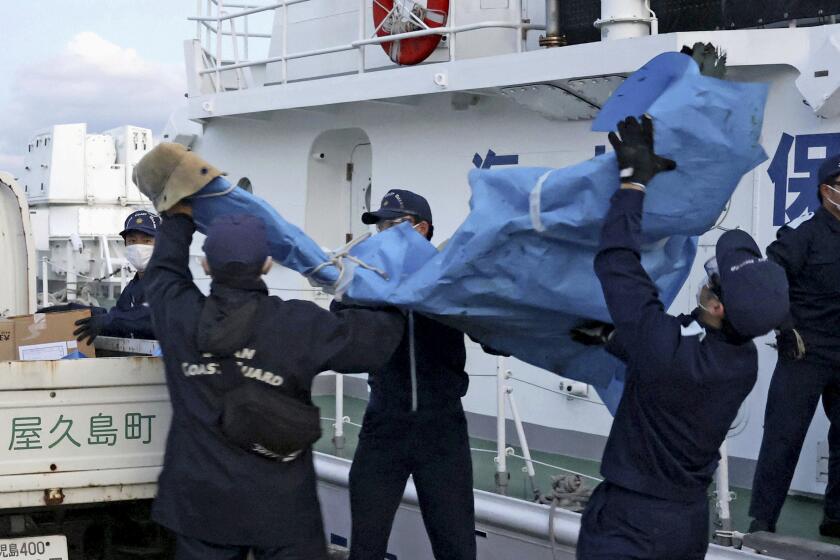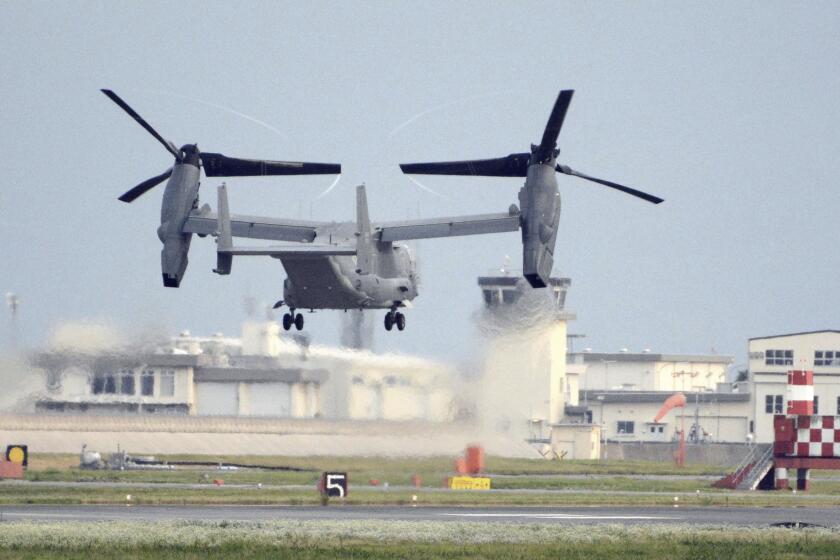U.S. military grounds its Osprey fleet after deadly air crash off Japan’s coast

- Share via
WASHINGTON — The military announced late Wednesday that it was grounding all of its Osprey V-22 helicopters, one week after eight Air Force Special Operations Command service members died in a crash off the coast of Japan.
The Air Force, Navy and Marine Corps took the extraordinary step of grounding hundreds of aircraft after a preliminary investigation of last week’s crash indicated that a materiel failure — something went wrong with the aircraft — and not a mistake by the crew led to the deaths.
The crash raised new questions about the safety of the Osprey, which has been involved in multiple fatal accidents over its relatively short time in service. Japan grounded its fleet of 14 Ospreys after the crash.
Lt. Gen. Tony Bauernfeind, head of Air Force Special Operations Command, directed the stand-down “to mitigate risk while the investigation continues,” the command said in a statement. “Preliminary investigation information indicates a potential materiel failure caused the mishap, but the underlying cause of the failure is unknown at this time.”
The U.S. Air Force has identified the eight service members lost when their Osprey aircraft crashed off the coast of Japan last week.
In a separate notice, Naval Air Systems Command said it was grounding all Ospreys. The command is responsible for the Marine Corps and Navy variants of the aircraft.
The Air Force said it was unknown how long the aircraft would be grounded. It said the stand-down was expected to remain in place until the investigation determined the cause of the Japan crash and made recommendations to allow the fleet to return to operations.
The U.S.-made Osprey is a hybrid aircraft that takes off and lands like a helicopter but can rotate its propellers forward and cruise much faster, like an airplane, during flight.
Its unique design has been a factor in multiple incidents. Although the investigation into last week’s crash has only just begun, it renewed attention on the aircraft’s safety record, particularly on a mechanical problem with the clutch that has troubled the program for more than a decade. There also have been questions as to whether all parts of the Osprey have been manufactured according to safety specifications.
The U.S. Air Force says divers have discovered the wreckage and remains of some crew members of an aircraft that crashed off southwestern Japan.
In August, the Marines found that a fatal 2022 Osprey crash was caused by a clutch failure, but the root cause was still unknown. In its report on the crash, the Marine Corps warned that future incidents “are impossible to prevent” without improvements to flight control system software, drivetrain component material strength, and robust inspection requirements.”
The Air Force Special Operations Command has 51 Ospreys, the Marine Corps flies as many as 400 and the Navy operates 27.
The Osprey is still a relatively young aircraft in the military’s fleet — the first Ospreys became operational in 2007 only after decades of testing. But more than 50 troops have died either flight-testing the Osprey or conducting training flights in the aircraft, including 20 deaths in four crashes over the last 20 months.
An Osprey accident in August in Australia killed three Marines. That accident is still under investigation.
More to Read
Sign up for Essential California
The most important California stories and recommendations in your inbox every morning.
You may occasionally receive promotional content from the Los Angeles Times.















